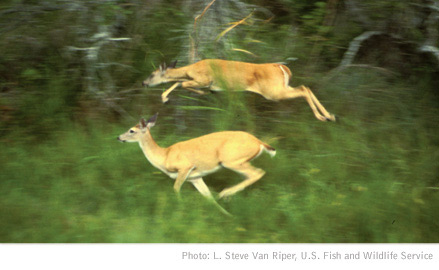


by Rory Sheats and Kathleen Cason
Intro
| The scent of a deer
| What deer see and hear
| Managing the herd

The scent of a deer
Mature white-tailed bucks give off a nose-wrinkling, musky smell during breeding season. The overpowering odor is produced by a behavior called “rub-urination” where deer rub their hind legs together as they urinate onto their tarsal glands, which are located on the inner leg at the hocks. Specialized tufts of hair around the glands trap the urine, which combines with bacteria and a fatty secretion to produce the characteristic scent. In some ways, it’s similar to the way sweat and bacteria cause underarm odor in people.“White-tailed deer actually have seven areas of glandular activity that are important in scent communication,” Miller said. “The tarsal glands are the ones that researchers understand the best and are the most important in communication among white-tailed deer.”
Miller’s team, which includes a dozen graduate students, takes various approaches in figuring out when and how deer scents are used to communicate and to determine differences associated with gender, age and season. The researchers analyze deer behavior at the university’s Whitehall Deer Research Facility in Athens, Ga., and at field sites across the country.

“For example, Dr. Miller used the captive-deer research facility to better understand how bucks use scent and visual marking of their habitat to communicate with does and other bucks,” said David Osborn, a UGA wildlife research coordinator and member of Miller’s group.
But they also use the laboratory to uncover other types of information.
“Not only have we done the basic behavioral research and looked at the morphology and function of these glands but we’ve also carried it to the next step,” Osborn said. “We’ve looked at chemicals associated with the glands and identified which bacteria interact with the urine to produce the odors.”
Tarsal-gland odor conveys socially important information to deer. It helps a doe identify her offspring, for instance. And bucks use the smell to display dominance and breeding condition to other deer, especially in breeding season, when bucks paw the ground and rub-urinate to make a “scrape” that marks territory. “It ’s the equivalent of a singles bar for deer,” Osborn said.
Rub-urination studies also may help scientists better understand biological processes such as mating. Researchers have learned that both male and female deer - during every season of the year and practically from birth - engage in rub-urination behavior. However, Miller’s studies have shown that dominant bucks urinate onto the tarsal gland much more frequently during the breeding season. Frequent rub-urination leads to chemical changes that stain the gland a dark, rusty color and give the buck its rutting odor.
“Clearly this rutting odor is important in establishing the pecking order among bucks during the breeding season,” Miller said. “However, we also have demonstrated that this odor from males can have a profound impact on the internal hormone secretions and timing of estrus among females.”
Miller’s studies of the tarsal gland may be the basis for future techniques to attract or repel deer. For instance, his findings may prove useful to hunters looking for any advantage to help bring home a prize buck. “Placing tarsal scent into a scrape may mimic a dominance challenge and perhaps cause the buck to return more often to his scrape,” he said.
Deer are particularly adept at interpreting these scents because they have a “second nose” on the roof of the mouth. This additional nose, called the vomeronasal organ or VNO, is somewhat similar to the organ snakes use to “taste” the air. In deer, the VNO appears to be used primarily to analyze urine, Miller said. When a buck sees a doe urinate, he often will take some of the urine into his mouth, introducing the scent to the VNO. Because the VNO is connected to the part of the brain that controls the deer’s reproductive condition, the scent stimulates hormones that affect the buck’s rutting condition.
Intro
| The scent of a deer
| What deer see and hear
| Managing the herd
For comments or for information please e-mail the editor: jbp@ovpr.uga.edu
To contact the webmaster please email: ovprweb@uga.edu
![]()